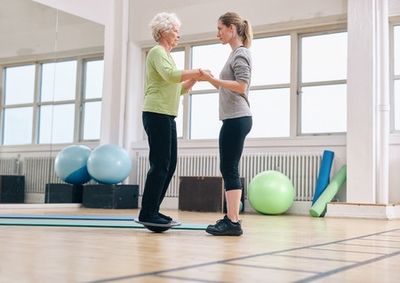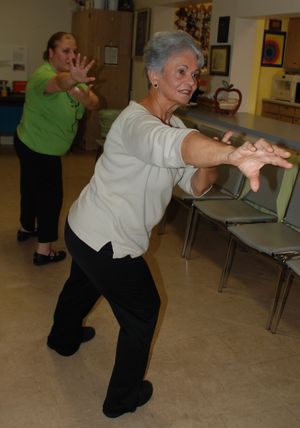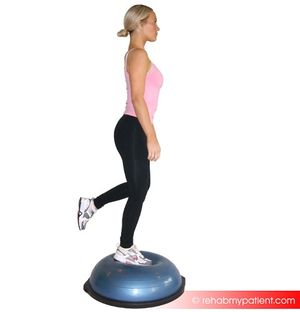Balance Training: Difference between revisions
Kim Jackson (talk | contribs) m (Text replacement - "[[MS Multiple Sclerosis" to "[[Multiple Sclerosis (MS)") |
Candace Goh (talk | contribs) No edit summary |
||
| Line 12: | Line 12: | ||
* Improve [[Strength and Conditioning|strength]] | * Improve [[Strength and Conditioning|strength]] | ||
* Improve standing balance and locomotor performance in older adults | * Improve standing balance and locomotor performance in older adults | ||
* Improves dynamic trunk control, sitting & standing balance, mobility in persons post [[stroke]]<ref>Van Criekinge T, Truijen S, Schröder J, Maebe Z, Blanckaert K, van der Waal C, Vink M, Saeys W. The effectiveness of trunk training on trunk control, sitting and standing balance and mobility post-stroke: a systematic review and meta-analysis. Clinical rehabilitation. 2019 Jun;33(6):992-1002.</ref>. | |||
* Strengthen self-efficacy in balance control leading to improved fall-related self-efficacy, reduced fear of falling, increased walking speed, and improved [[Physical Activity|physical function]]<ref>Halvarsson A, Dohrn IM, Ståhle A. [https://www.ncbi.nlm.nih.gov/pmc/articles/PMC4419050/ Taking balance training for older adults one step further: the rationale for and a description of a proven balance training] programme. Clinical rehabilitation. 2015 May;29(5):417-25.Available from:https://www.ncbi.nlm.nih.gov/pmc/articles/PMC4419050/ (last accessed 17.10.2020)</ref>. | * Strengthen self-efficacy in balance control leading to improved fall-related self-efficacy, reduced fear of falling, increased walking speed, and improved [[Physical Activity|physical function]]<ref>Halvarsson A, Dohrn IM, Ståhle A. [https://www.ncbi.nlm.nih.gov/pmc/articles/PMC4419050/ Taking balance training for older adults one step further: the rationale for and a description of a proven balance training] programme. Clinical rehabilitation. 2015 May;29(5):417-25.Available from:https://www.ncbi.nlm.nih.gov/pmc/articles/PMC4419050/ (last accessed 17.10.2020)</ref>. | ||
* | |||
Decreased balance is attributable to an age-related decline in multiple physiological systems that contributes to: | Decreased balance is attributable to an age-related decline in multiple physiological systems that contributes to: | ||
* Decreased muscle flexibility and strength, | * Decreased muscle flexibility and strength, | ||
| Line 28: | Line 30: | ||
== For Whom == | == For Whom == | ||
Having good balance is important for many activities people do every day | Having good balance is important for many activities people do every day e.g walking, putting clothes on the line, reaching up or down into cupboards, going up and down the stairs. [[File:Taoist Tai Chi class.jpg|right|frameless]]Exercises that improve balance can help prevent falls, a common problem in many populations e.g | ||
* [[Older People - An Introduction|Older adults]] | * [[Older People - An Introduction|Older adults]] | ||
* [[Neuromuscular Disorders|Neuromuscula]]<nowiki/>r conditions ([[Multiple Sclerosis (MS)|multiple sclerosis]], [[Parkinson's|parkinsonism,]] [[stroke]]), | * [[Neuromuscular Disorders|Neuromuscula]]<nowiki/>[[Neuromuscular Disorders|r]] conditions ([[Multiple Sclerosis (MS)|multiple sclerosis]], [[Parkinson's|parkinsonism,]] [[stroke]]), | ||
* [[Cancer Rehabilitation and the Importance of Balance Training|Cancer Rehabilitation]] | * [[Cancer Rehabilitation and the Importance of Balance Training|Cancer Rehabilitation]] | ||
* [[Amputee Case Presentation - The Diabetic Amputee: Amputee Case Study|Amputees]] | * [[Amputee Case Presentation - The Diabetic Amputee: Amputee Case Study|Amputees]] | ||
* Those who are [[Obesity|obese]] since weight is not always carried or distributed evenly throughout the body. | * Those who are [[Obesity|obese]] since weight is not always carried or distributed evenly throughout the body. | ||
* [[Low Back Pain|Back pain]] (balance training is one of the best ways to strengthen your core and prevent back pain). | * [[Low Back Pain|Back pain]] (balance training is one of the best ways to strengthen your core and prevent back pain). | ||
| Line 64: | Line 66: | ||
* Using equipment, like a [[Balance Boards|Bosu,]] (or other [[Balance Boards|balance board]]) which has an inflatable dome on top of a circular platform, which challenges balance | * Using equipment, like a [[Balance Boards|Bosu,]] (or other [[Balance Boards|balance board]]) which has an inflatable dome on top of a circular platform, which challenges balance | ||
* [[Otago Exercise Programme|The Otago Exercise Program]] | * [[Otago Exercise Programme|The Otago Exercise Program]] | ||
* [[Perturbation-Based Balance Training|Perturbation-based balance]] training (an intervention involving repeated postural perturbations aiming to improve control of rapid balance reactions). | * [[Perturbation-Based Balance Training|Perturbation-based balance]] training (an intervention involving repeated postural perturbations aiming to improve control of rapid balance reactions). This training has been proven to improve reactive balance control in post-stroke individuals during sub-acute phase<ref>Schinkel-Ivy, A., Huntley, A.H., Danells, C.J., Inness, E.L. and Mansfield, A., 2020. Improvements in balance reaction impairments following reactive balance training in individuals with sub-acute stroke: a prospective cohort study with historical control. ''Topics in stroke rehabilitation'', ''27''(4), pp.262-271.</ref>. | ||
Over time, you can make these exercises harder by: | Over time, you can make these exercises harder by: | ||
* Holding the position for a longer amount of time | * Holding the position for a longer amount of time | ||
Revision as of 16:20, 27 January 2022
Original Editor - Lucinda hampton
Top Contributors - Ahmet Begde, Lucinda hampton, Anthonia Abraham, Kim Jackson, Oyemi Sillo, Candace Goh, Aminat Abolade and Nupur Smit Shah
Introduction[edit | edit source]
Balance exercise is one of the four types of exercise along with strength, aerobic and flexibility exercises.
Balance training is undertaken in order to
- Prevent falls/injury
- Improve posture
- Improve strength
- Improve standing balance and locomotor performance in older adults
- Improves dynamic trunk control, sitting & standing balance, mobility in persons post stroke[1].
- Strengthen self-efficacy in balance control leading to improved fall-related self-efficacy, reduced fear of falling, increased walking speed, and improved physical function[2].
Decreased balance is attributable to an age-related decline in multiple physiological systems that contributes to:
- Decreased muscle flexibility and strength,
- Reduced central processing of sensory information
- Slowed motor responses.
In addition to an increased risk of falls, diminished balance and mobility may limit
- Activities of daily living
- Participation in leisure-time activities.
Accordingly, it is essential that balance exercises be incorporated into the physical activity programs of older adults.[3]
Aims[edit | edit source]
Balance training programs aim to:
- Strengthen balance control in everyday activities leading to improved fall-related self-efficacy, reduced fear of falling and increased walking speed
- Improve physical function
- Improve quality of life
For Whom[edit | edit source]
Having good balance is important for many activities people do every day e.g walking, putting clothes on the line, reaching up or down into cupboards, going up and down the stairs.
Exercises that improve balance can help prevent falls, a common problem in many populations e.g
- Older adults
- Neuromuscular conditions (multiple sclerosis, parkinsonism, stroke),
- Cancer Rehabilitation
- Amputees
- Those who are obese since weight is not always carried or distributed evenly throughout the body.
- Back pain (balance training is one of the best ways to strengthen your core and prevent back pain).
Preferably, older adults and those at risk of falls should do balance training 3 or more days a week and do standardized exercises from a program demonstrated to reduce falls.
It’s not known whether different combinations of type, amount, or frequency of activity can reduce falls to a greater degree.
Tai chi exercises also may help prevent falls. Balance, strength and flexibility exercises can be combined[4].
Exercises and Implementation[edit | edit source]
A client must have a balance assessment prior to commencing a balance program.
- With now an emphasis in therapy towards evidenced-based practice to demonstrate the effectiveness of certain intervention special balance tests have evolved. Many exist (see outcome measures below), choose appropriately. These tests are used to assess patient’s abilities pre and post interventions.
Based on the literature
- Older adults be exposed to a program that includes flexibility and balance exercises for 2–3 sessions each week, for periods of at least 8 weeks, as a tool for quality of life improvement.
- Introduce the exercises gradually, allowing for the proper adjustment of the clients while ensuring their safety.
- Allow for gradual and safe exposure to new equipment or a new exercise
The program should incorporate exercises that include
- Static vs. dynamic stability postures,
- Changes in the base of support,
- Variations in the height of the centre of gravity
- Different standing surfaces.
Additionally, it should progressively reach higher levels of challenges in the form of more complex exercises involving both motor and cognitive tasks (dual- and multi-task activities)[5].
Examples of balance exercises include:
- Standing, weight on one leg and raising the other leg to the side or behind.
- Putting heel right in front of your toe ie tandem stance
- Standing up and sitting down from a chair without using hands
- Walking while alternating knee lifts with each step
- Doing tai chi or yoga. Tai chi is a time-honored martial art that involves slow, rhythmic movements, including rotation of the trunk, shifting weight, coordination, and a gradual progression to narrowing the lower extremity stance. It has gained recognition as a good exercise choice for the elderly. Studies have shown tai chi improves postural stability more so than other exercises. It also offers multiple musculoskeletal and cardiopulmonary benefits.[6]
- Using equipment, like a Bosu, (or other balance board) which has an inflatable dome on top of a circular platform, which challenges balance
- The Otago Exercise Program
- Perturbation-based balance training (an intervention involving repeated postural perturbations aiming to improve control of rapid balance reactions). This training has been proven to improve reactive balance control in post-stroke individuals during sub-acute phase[7].
Over time, you can make these exercises harder by:
- Holding the position for a longer amount of time
- Walking tandem stance with support then without (see Otago)
- Closing eyes
- Letting go of chair or other support[8]
Outcome Measures[edit | edit source]
Many exists some are listed below
- 4 Stage Balance Test
- Berg Balance Scale to evaluate static and dynamic balance, the
- Falls risk assessment tool
- Timed Up and Go Test to assess a patient's mobility
- The Balance Outcome Measure for Elder Rehabilitation
- Functional Reach
References[edit | edit source]
- ↑ Van Criekinge T, Truijen S, Schröder J, Maebe Z, Blanckaert K, van der Waal C, Vink M, Saeys W. The effectiveness of trunk training on trunk control, sitting and standing balance and mobility post-stroke: a systematic review and meta-analysis. Clinical rehabilitation. 2019 Jun;33(6):992-1002.
- ↑ Halvarsson A, Dohrn IM, Ståhle A. Taking balance training for older adults one step further: the rationale for and a description of a proven balance training programme. Clinical rehabilitation. 2015 May;29(5):417-25.Available from:https://www.ncbi.nlm.nih.gov/pmc/articles/PMC4419050/ (last accessed 17.10.2020)
- ↑ NeuRa Balance training Available from:https://www.neura.edu.au/health/balance-training/ (Last accessed 17.10.2020)
- ↑ AHA Balance exercises Available from:https://www.heart.org/en/healthy-living/fitness/fitness-basics/balance-exercise (last accessed 17.10.2020)
- ↑ Dunsky A. The effect of balance and coordination exercises on quality of life in older adults: a mini-review. Frontiers in aging neuroscience. 2019;11.Available from:https://www.frontiersin.org/articles/10.3389/fnagi.2019.00318/full
- ↑ Appeadu M, Bordoni B. Falls and Fall Prevention. StatPearls [Internet]. 2020 Jul 8.Available from:https://www.ncbi.nlm.nih.gov/books/NBK560761/ (last accessed 17.10.2020)
- ↑ Schinkel-Ivy, A., Huntley, A.H., Danells, C.J., Inness, E.L. and Mansfield, A., 2020. Improvements in balance reaction impairments following reactive balance training in individuals with sub-acute stroke: a prospective cohort study with historical control. Topics in stroke rehabilitation, 27(4), pp.262-271.
- ↑ Web MD Balance training Available from:https://www.webmd.com/fitness-exercise/a-z/balance-training (last accessed 17.10.2020)









